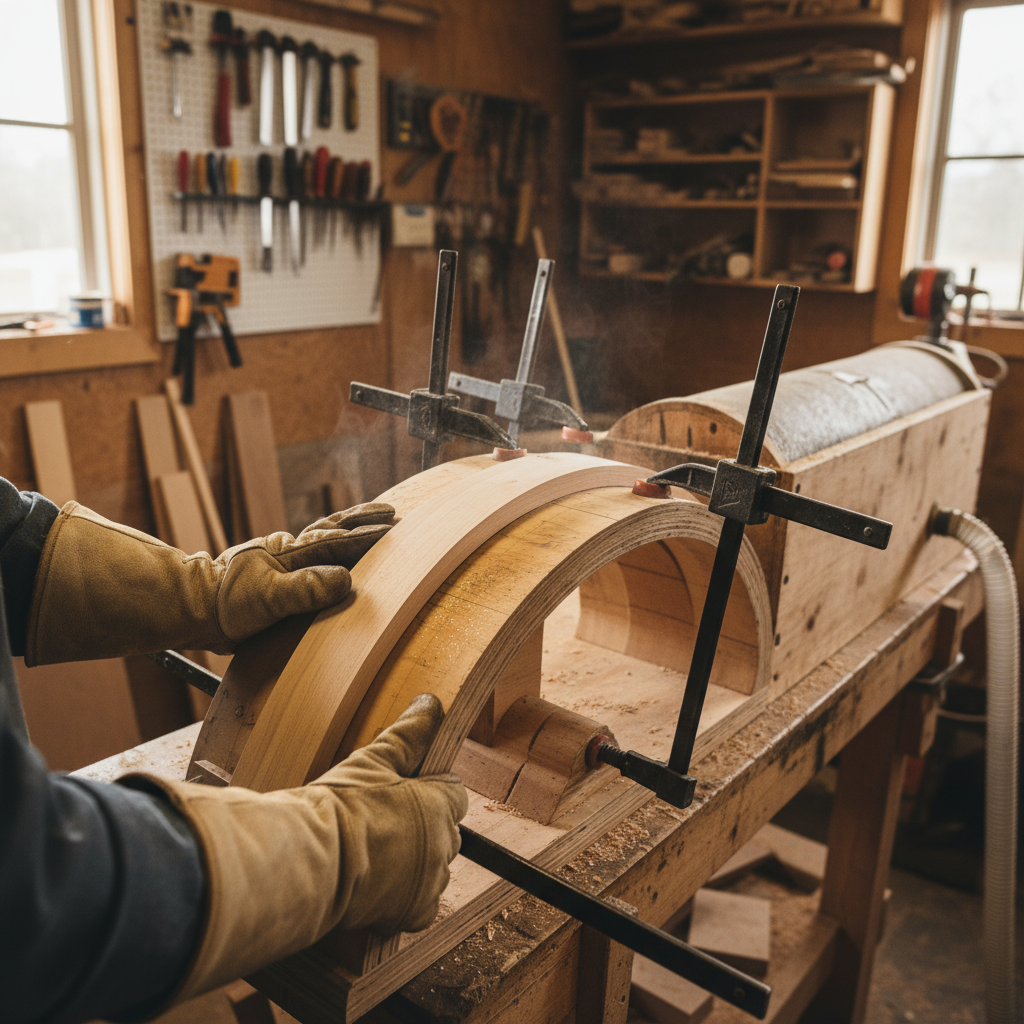Ever gazed at a beautifully curved chair back and wondered how they got the wood to bend like that without snapping? It’s not magic, it’s steam bending! As someone who’s spent countless hours in the workshop, I can tell you there’s a unique satisfaction in taking a straight piece of timber and transforming it into an elegant curve with nothing but heat, moisture, and a bit of patience. If you’re ready to add that touch of bespoke craftsmanship to your next furniture project, particularly a stuing chair back, then you’ve come to the right place. We’re going to dive deep into the art and science of steam bending, covering everything you need to know to achieve those perfect, flowing lines for your chair.
Steam bending isn’t just about aesthetics; it’s also incredibly strong. Unlike cutting curves from thicker stock, which severs wood fibers and weakens the piece, steam bending preserves the continuous grain, making the bent component stronger and more resilient. Plus, it’s a fantastic way to conserve wood, as you’re not turning half of your material into sawdust. Ready to unleash your ier wood whisperer?
Gather Your Arsenal: What You’ll Need
Before we turn up the heat, let’s make sure you’ve got all the essential tools and materials. Think of this as your mission briefing for a successful bend.
- Wood Stock: This is crucial. We’ll talk about types in detail next, but generally, choose straight-grained, knot-free pieces, ideally slightly oversized.
- Steam Box: You can buy one, or easily build one yourself (more on this soon!). It needs to be long enough for your chair back piece, insulated, and sealable.
- Steam Source: A wallpaper steamer is perfect for this. Alternatively, a large kettle with a hose adapter can work for smaller setups.
- Bending Form/Jig: This is your mold, which dictates the final shape of your chair back. It needs to be robust and able to withstand significant clamping pressure.
- Clamps: Lots of them! Bar clamps, pipe clamps, quick-grip clamps – you’ll need a variety to secure the wood to your form quickly and evenly.
- Heavy-Duty Gloves: Essential for handling hot wood.
- Safety Glasses: Always.
- Measuring Tape and Pencil: For marking and measuring.
- Rags/Towels: For cleanup and wiping condensation.
- Optional (but recommended): A steel bending strap with end stops. This helps prevent the wood from failing on the outside (tension side) of the bend, allowing for tighter curves.
The Right Wood Makes All The Difference
Not all wood is created equal when it comes to steam bending. Some species are incredibly cooperative, while others will fight you every inch of the way, usually resulting in a spectacular crack. From my experience, selecting the right wood is perhaps the most critical step.
Choosing Your Species
Look for porous woods with an open grain structure. These allow the steam to penetrate deeply and plasticize the wood fibers effectively. My go-to choices, and highly recommended for chair backs, are:
- White Oak & Red Oak: Excellent bending properties. White oak is particularly good.
- Ash: Another fantastic option, very forgiving and strong.
- Hard Maple: Good, but can be a bit more challenging for very tight bends.
- Walnut & Cherry: Can be bent, but might require a little more care and less aggressive bends.
- Elm: Historically used and bends beautifully.
Avoid woods like most pines, firs, and other softwoods, as they tend to crush and splinter. Exotic hardwoods can be a gamble, so stick to the tried and true for your first attempts.
Grain Direction and Moisture Content
Straight Grain: This is non-negotiable. Any run-out (grain that isn’t parallel to the length of the board) or knots will almost guarantee a break. Spend time selecting boards that are perfectly clear and straight-grained. If possible, consider riven (split) timber, as it naturally follows the grain and is ideal for bending, though sawn stock is more commonly available.
Moisture Content: Aim for wood that’s air-dried, ideally with a moisture content of 15-20%. Kiln-dried wood can be bent, but it’s often more brittle and might require re-wetting for several days or even weeks prior to steaming. Personally, I prefer working with air-dried wood when I can get it – it just feels more alive and willing to bend.
Dimensions: For a chair back, you’re likely working with pieces around 1/2″ to 3/4″ thick, perhaps 1.5″ to 2″ wide. The general rule of thumb for steaming time is 1 hour per inch of thickness. For a 3/4″ piece, that’s about 45 minutes.
Building Your Simple Steam Box
You don’t need a fancy setup. I’ve seen everything from PVC pipes to old refrigerators repurposed as steam boxes. The key is efficiency and safety.
Design Essentials:
- Container: A long, sealed box made from plywood (sealed internally with epoxy or exterior paint to prevent warping), or even a large diameter PVC pipe. It needs to be slightly longer than your longest piece of wood.
- Steam Inlet: A hole to coect your steam source hose. This should be at one end, allowing steam to travel the full length.
- Drainage: A small hole at the bottom of one end (opposite the inlet, or just at the lowest point) to allow condensed water to escape.
- Wood Support: Internal battens or a metal rack to keep the wood off the bottom, allowing steam to circulate all around it.
- Door/Lid: A sealable door at one end for inserting and retrieving the wood. Clamps or latches will keep it shut tight. A small vent hole (around 1/4″) on the door or at the far end helps ensure proper steam flow and pressure equilibrium.
Ensure your steam source (wallpaper steamer) has sufficient water and is producing a good, steady flow of steam before you even think about putting wood in the box. You want a constant, dense cloud of steam, not just a wisp.
Crafting Your Bending Form
This is where your chair back’s personality takes shape. The form needs to be sturdy enough to resist the spring-back of the wood, which can be considerable.
- Material: Plywood, MDF, or even solid wood can work. Layering multiple pieces of plywood is a common and effective method for strength.
- Shape: Draw your desired curve onto a sheet of plywood. Remember to account for “spring-back.” Wood will always try to return to its original straight shape slightly. So, you’ll need to over-bend your form by about 10-20% more than your final desired curve. For example, if you want a 4-inch deep curve, your form might need to be 4.5-5 inches deep. This takes some trial and error, so practicing with scrap wood first is highly recommended.
- Clamping Points: Design your form with plenty of flat surfaces or additional blocks for your clamps to grip firmly. The quicker and more securely you can clamp the hot wood, the better your results will be.
Once your form is cut and sanded smooth, it’s ready for action. Having a helper for the bending stage can make a huge difference, especially with longer or thicker pieces.
The Moment of Truth: The Bending Process
This is where all your preparation pays off. It’s a bit of a race against time, so clarity and speed are key.
1. Steaming the Wood
Place your wood inside the steam box, ensuring it’s not touching the bottom. Close the lid tightly and start your steam source. Let it steam for approximately 1 hour per inch of thickness. For a 3/4″ piece, I’d usually go for about 45-50 minutes, maybe a full hour just to be safe. You want the wood to be pliable all the way through, almost like rubber.
During this time, double-check your form and clamps are ready, within easy reach, and perfectly positioned. Every second counts once that wood comes out of the box.
2. The Quick Draw and Clamp
Once steaming is complete, put on your heavy-duty gloves! This wood is HOT and saturated. Quickly but carefully remove the steamed wood from the box. If you’re using a steel bending strap, quickly position it around the wood.
Immediately place the wood (with or without the strap) onto your bending form. Start clamping from the center of the bend, working outwards towards the ends. Apply firm, even pressure. Don’t be shy with the clamps – the more the merrier – and ensure there are no gaps between the wood and the form. This entire process, from box to fully clamped, should ideally take no more than 30-60 seconds. The wood cools down rapidly, losing its pliability.
3. Drying and Setting
Now comes the waiting game. The wood needs to cool and dry completely while clamped to the form. This allows the cellulose and lignin in the wood to “set” in their new shape. I typically leave my pieces clamped for at least 24-48 hours, sometimes longer for thicker or more aggressive bends. Make sure there’s good air circulation around the clamped piece to aid drying.
Once you unclamp it, you’ll observe some spring-back, but your beautiful curve should largely hold its new shape. You can then trim, sand, and incorporate it into your chair design.
Tips from the Trenches for Success
- Practice on Scraps: Seriously, don’t use your prize lumber for your first bend. Use some cheaper, similar-species wood to get a feel for the process, steaming times, and spring-back.
- The Steel Strap is Your Friend: Especially for tighter radii, a steel bending strap (which compresses the inside of the bend and prevents tension failure on the outside) drastically increases your success rate.
- Work Quickly: I caot stress this enough. Have everything laid out and ready. Practice the clamping sequence dry.
- Don’t Over-steam: While under-steaming means the wood won’t bend, over-steaming can degrade the wood fibers, making them weak and punky. Stick to the 1 hour per inch rule.
- Consider Pre-Wetting: If you’re using very dry kiln-dried stock, submerging it in water for a few days to a week before steaming can help reintroduce some moisture and improve bending success.
Safety First, Always!
You’re dealing with very hot steam and potentially very hot wood. Always wear heavy-duty gloves and eye protection. Be mindful of where the steam is venting and don’t touch any hot metal parts of your steamer or steam box without protection. Use common sense, and if something feels unsafe, stop and re-evaluate.
Conclusion: Embrace the Curve!
Steam bending a chair back is one of those woodworking techniques that truly feels like an accomplishment. There’s a tangible transformation from flat board to elegant curve, and the strength and beauty it adds to a piece of furniture are unparalleled. It might seem intimidating at first, but with the right preparation, the correct wood, and a methodical approach, you’ll be creating stuing bentwood components io time.
So, go ahead, build that steam box, choose your wood, and get ready to impress yourself and others with your newfound ability to coax wood into submission. Your custom chair, with its perfectly steam-bent back, will be a testament to your skill and patience. Happy bending!



